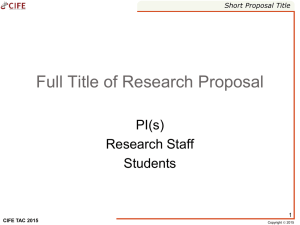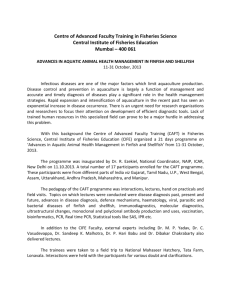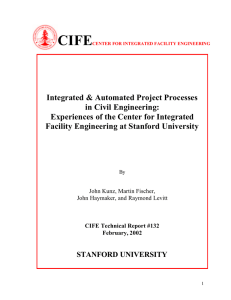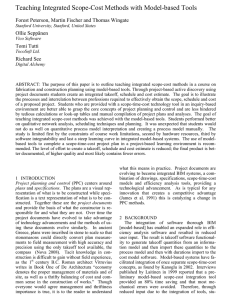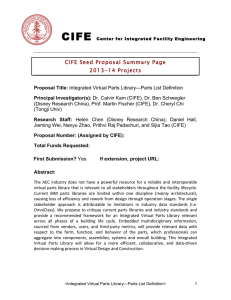CIFE CIFE Seed Proposal Summary Page 2012-13 Projects
advertisement
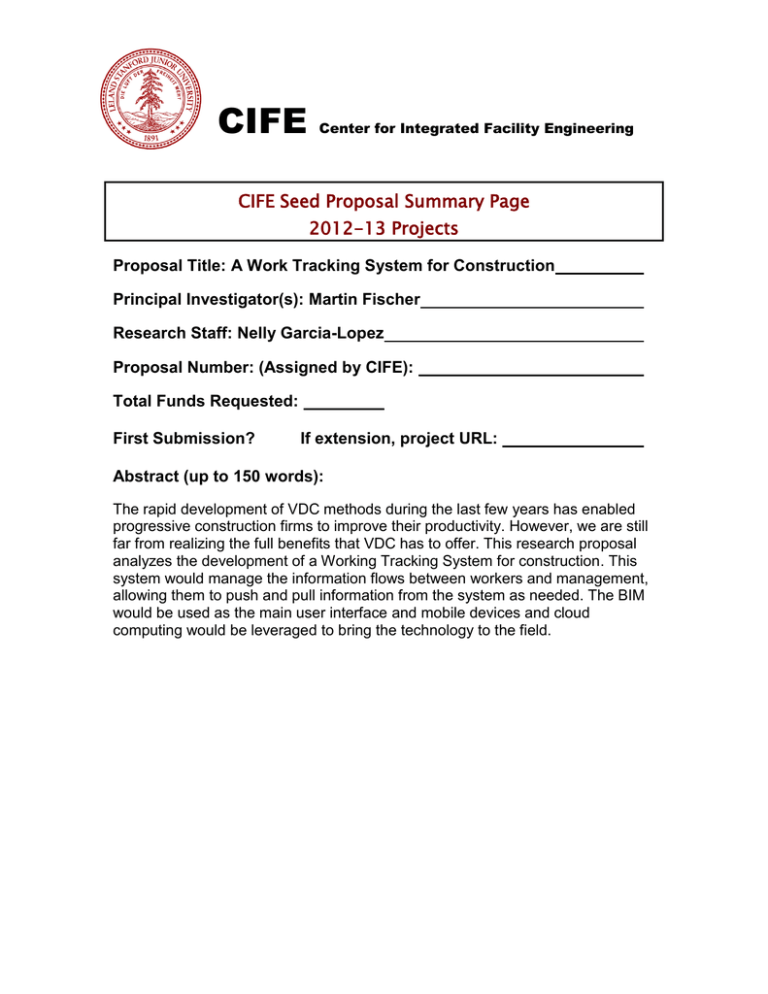
CIFE Center for Integrated Facility Engineering CIFE Seed Proposal Summary Page 2012-13 Projects Proposal Title: A Work Tracking System for Construction Principal Investigator(s): Martin Fischer Research Staff: Nelly Garcia-Lopez Proposal Number: (Assigned by CIFE): Total Funds Requested: First Submission? If extension, project URL: Abstract (up to 150 words): The rapid development of VDC methods during the last few years has enabled progressive construction firms to improve their productivity. However, we are still far from realizing the full benefits that VDC has to offer. This research proposal analyzes the development of a Working Tracking System for construction. This system would manage the information flows between workers and management, allowing them to push and pull information from the system as needed. The BIM would be used as the main user interface and mobile devices and cloud computing would be leveraged to bring the technology to the field. Introduction: Building Information Modeling is revolutionizing the construction industry and forcing it to adapt its traditional work processes to it. This generates an immense number of opportunities for progressive companies to leverage the new technology and get ahead of the competition. According to McGraw-Hill Construction, as of 2009 more than 50% of the construction industry in the United States is using BIM and seeing unprecedented improvements in productivity and positive returns on investment (Young Jr et al. 2009). This research proposes the development of an onsite Work Tracking System which leverages BIM, advances in cloud computing, pervasiveness of handheld devices and tablets and scheduling to track task completion and improve on site productivity. Motivating engineering/business problem Definition of task completion Working as a project engineer in a residential construction project in Colombia, I spent about 30% of my daily time walking through the site and taking note of the progress achieved by each of the different trades. This information was used to update the Microsoft Project schedule and calculate earned value as well as other subcontractor metrics and to schedule progress payments. Although this was a relatively easy task during the structural phase, it progressively got more complicated once more trades starting working through the building. The level of complexity peaked during the finishing phase, where you can have a number of different trades working side by side in a relatively small apartment space. Moreover, there was a disconnection between the level of detail we had in our schedule and the level of detail that we wanted to have of the work completed on site. For instance, for the paint activity the level of detail in the schedule might be limited to the apartment number whereas for coordination with the flooring subcontractor we would like to know what rooms in a certain apartment had been completed or were close to completion. Ideally, we would have liked to know exactly which elements of the building had been completed with a zero time lag in the information. This would have allowed us to make better business decisions based on subcontractor compensation, coordination between subcontractors among other scheduling decisions. We believe that leveraging BIM, cloud computing and hand held devices, we can create a Work Tracking System which shows the exact status of each of the Martin Fischer A Work Tracking System for Construction 2 tasks associated with every element in the building to empower superintendents to make better decisions. Quality checks, punch lists and signoff areas Currently, there is a long time lag from the moment a certain task is completed and the quality inspection. Generally, the quality inspection is performed to fulfill the requirements of a progress payment, rather than performed immediately after the task is completed. This results in finger pointing between trades once quality problems are detected and lengthily negotiations (mostly informal and sometimes formal) between them to determine who should be made responsible. If we had a system that alerted us as soon as a task was completed, we could quickly perform quality checks that detected issues, generate a punch list on the spot and generate signoff areas to avoid finger pointing. This should increase the quality of the work performed and reduce rework. Concurrent work and quality issues Extracting data from my work experience, I observed that rework and quality issues increased substantially when two subcontractors were working concurrently in the same area. Workers would shield each other from being accountable for quality issues, finger pointing would be prevalent and negotiations between them unfruitful. To avoid this issue, we can setup a Kanban system which should be supported by the Work Tracking System which would only allow subcontractors to start work in one area once it has been signed off. Theoretical and Practical Point of Departure In my experience of managing multi-family housing projects in Colombia for 2 years, I have found that timely communications are critical to avoid construction rework. In residential construction, rework can amount to 10% during the finishing phase. Rework leads to wasted time, materials and energy. One of the main causes of rework is minor quality issues detected in punch lists. Emerging IT platforms such as smartphones and tablets allow the workforce and project management to work together more effectively through timelier, quicker, and better targeted (relevant) two-way communication which reduces the time between work completion and work signoff. Software packages such as Vela Systems allow workers to create punch lists directly in the field using Ipads (Vela Systems). One of the ways of responding to these challenges and opportunities, is by empowering construction workers by leveraging VDC methods (Kunz and Fischer 2005) to effectively bring “power to the edge” (Levitt 2011; Alberts and Martin Fischer A Work Tracking System for Construction 3 Hayes 2005). However, there are important theoretical gaps to bring power to the edge, i.e., enable the construction workforce to work hand in hand with project management. Key gaps I am addressing in my research are the lack of a clear definition of completeness of design information and schedules, i.e., a clear definition for the quality of the information laborers need for safe and productive construction, and the lack of a clear definition of work completion, i.e., “what done” looks like. Without such definitions, management techniques such as Kanban (Ohno 1988) that have helped the manufacturing industry to reduce variability, reduce waste, increase output, and improve quality cannot be applied effectively in construction. Furthermore, there is a need to align the level of detail in which scheduling is done with the level of detail of construction planning and tracking to support management decision making in the field. Location based scheduling methods developed by CIFE members are key to supporting this area (Akinci et al. 2000; Koo et al. 2007; Morkos et al. 2012; Dong et al. 2012). Method This research will answer a fundamental question which is: what information do we need to capture and manage to successfully track work status and completion to inform decision making? Figure 1: Work Tracking System manages the information which needs to be shared with the workers and managers to facilitate project delivery and decision making. Martin Fischer A Work Tracking System for Construction 4 The Work Tracking System proposed leverages VDC, IT and Organization methods to deliver the information which workers and managers need in real time to facilitate project delivery and decision making. This research will look into what information flows should be pushed and pulled to and from the different actors to support project objectives. It will also analyze the definition of task completion and determine ways this information can be communicated to all stakeholders interested to support decision making such as the generation of look-ahead schedules, construction sequencing and coordination between subcontractors. It will also determine what information is needed to setup a Kanban project delivery system for construction. This system would be hosted in a cloud-based environment which should be easily accessed using mobile interfaces such as smart phones and tablets. To answer these questions, we will develop a system based on theory and industry best practices. It will then be streamlined through charretes composed of interdisciplinary teams, where different stakeholders from industry will be asked to provide feedback about the system and propose changes. Relationship to CIFE goals This research supports CIFE goals directly. Its emphasis is to improve construction operations through the innovative integration of BIM and metadata such as task status attached to specific BIM elements, which is updated through a simple mobile interface by construction workers and managers. Furthermore, through the development and implementation of this project management tool latency should be reduced considerably. Industry involvement As stated in the method section, industry involvement in the project will be sought in two ways. The first is a research of industry best practices regarding information exchange and management. The second is through the charretes which will be held towards the second half of the project to provide input about the proposed system and suggest changes. Research plan schedule and risks The following are the major milestones for the project: November 2012: Complete industry review of best practices in information exchange and management. Martin Fischer A Work Tracking System for Construction 5 December 2012: Complete project website. March 2013: Complete technical revision to push and pull information using the BIM model as an interface. April 2013: Hold Industry Charretes with interdisciplinary teams. September 2013: Complete project, submit report. The main risk for the project is a technical risk involved in integrating the different interfaces and completing the project on time. Next Steps At the end of the project we would like to have a prototype of what the interface would look like and how we would like it to work. However, developing a working prototype is out of the scope of the project because of time limitations. Hence, the logical next step would be to develop this prototype either through further CIFE founding or partnering with industry. Budget References Akinci, Burcu, Martin Fischer, John Kunz, and Ray Levitt. 2000. “Automated Generation of Work Spaces.” CIFE Technical Report (58): 1-37. http://cife.stanford.edu/sites/default/files/WP058.pdf. Alberts, David S, and Richard E Hayes. 2005. Power to the Edge. CCRP Publication Series. http://www.dodccrp.org/files/Alberts_Power.pdf. Dong, Ning (Tony). 2012. Quick Generation of Close-to-Optimum Look-Ahead Schedules for the Finishing Phase of Complex Projects. Koo, Bonsang, Martin Fischer, and John Kunz. 2007. “A Formal Identification and Re-sequencing Process for Rapid Generation of Sequencing Alternatives in CPM Schedules.” CIFE Technical Report 168 (# 168). http://cife.stanford.edu/sites/default/files/TR168.pdf. Kunz, J., and M. Fischer. 2005. “Virtual design and construction: themes, case studies and implementation suggestions.” CIFE, Stanford University, Stanford, CA, CIFE Working Paper 97 (March). http://www.stanford.edu/group/CIFE/online.publications/WP097v12.pdf. Levitt, Raymond E. 2011. “Towards project management 2.0.” Engineering Project Organization Journal 1 (3) (September): 197-210. Martin Fischer A Work Tracking System for Construction 6 doi:10.1080/21573727.2011.609558. http://www.tandfonline.com/doi/abs/10.1080/21573727.2011.609558. Morkos, Rene. 2012. A method for creating construction schedules by generating relationships between zones from object oriented models and construction method model recipes. Ohno, Taiichi. 1988. Toyota Production System: Beyond Large-Scale Production. 1st Editio. Portland: Productivity Press. Vela Systems. Vela Systems. http://www.velasystems.com/. Young Jr, Norbert W, Stephen A. Jones, Harvey M. Bernstein, and John E. Gudgel. 2009. The Business Value of BIM Getting Building Information Modeling to the Bottom Line. New York. http://www.tpm.com/images/stories/documents/autodesk/Final_2009_BIM_S martMarket_Report.pdf. Martin Fischer A Work Tracking System for Construction 7
